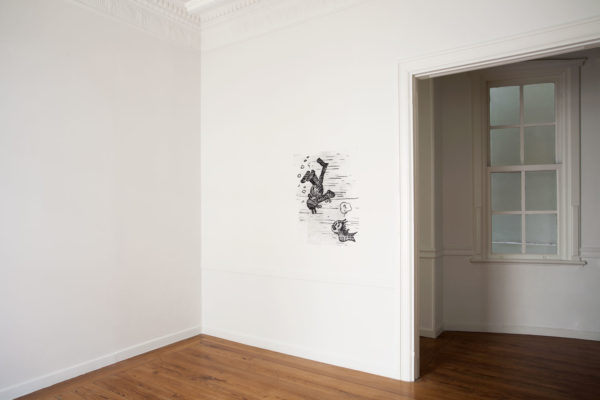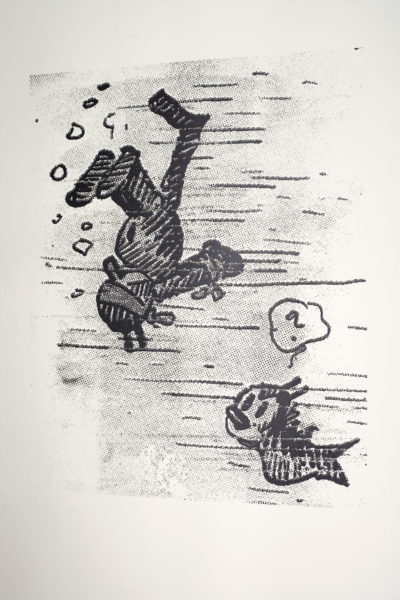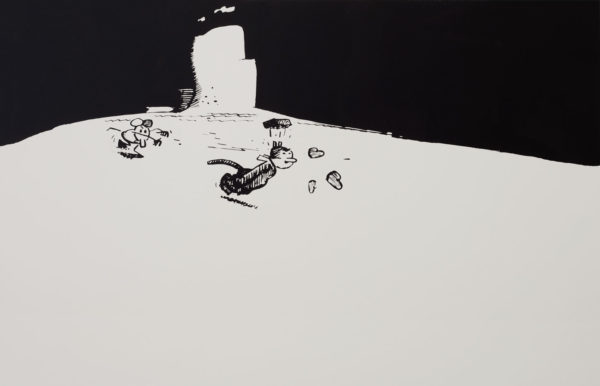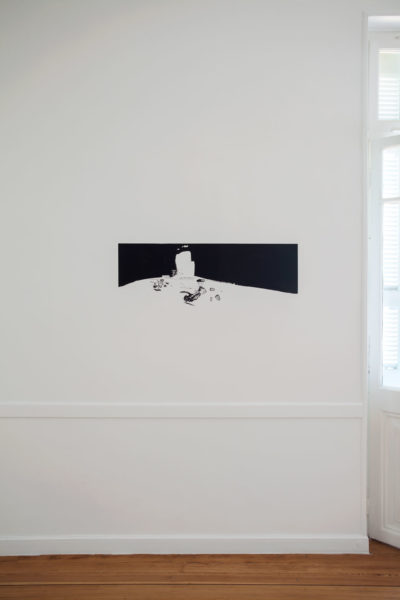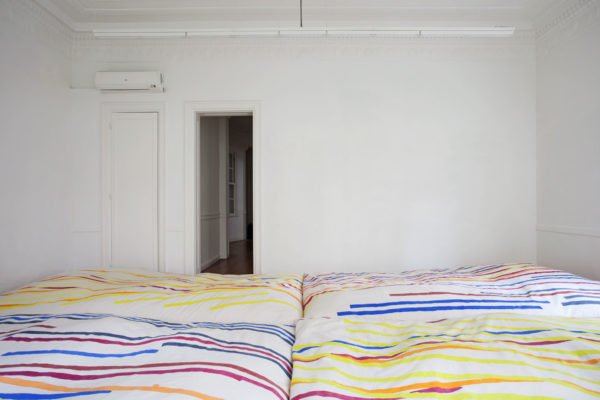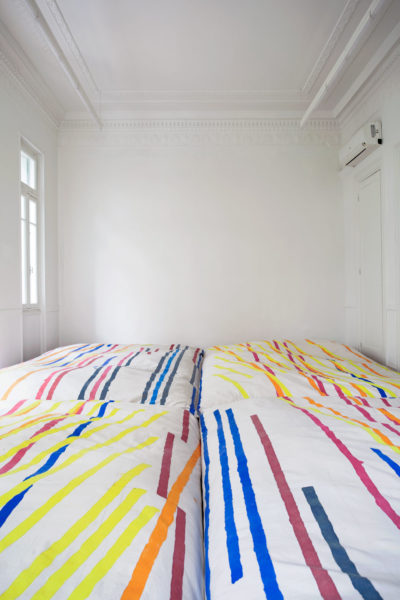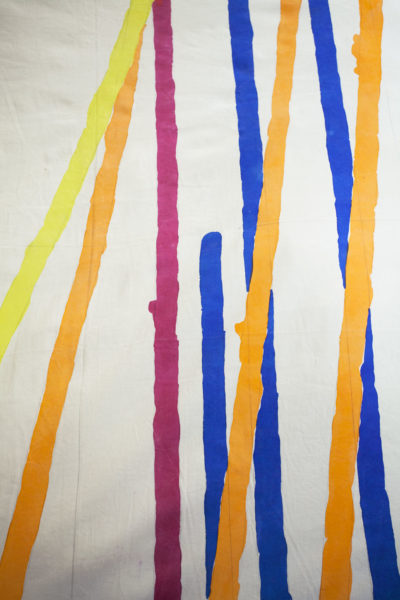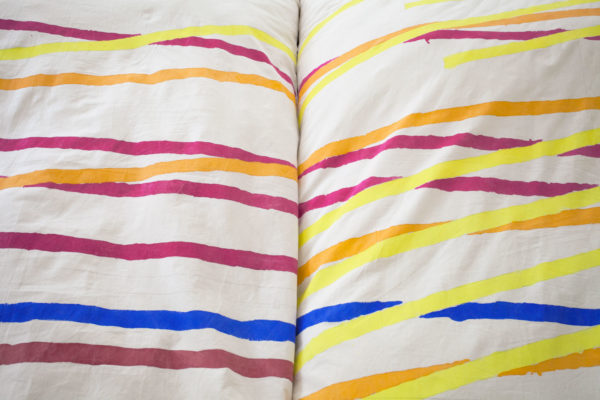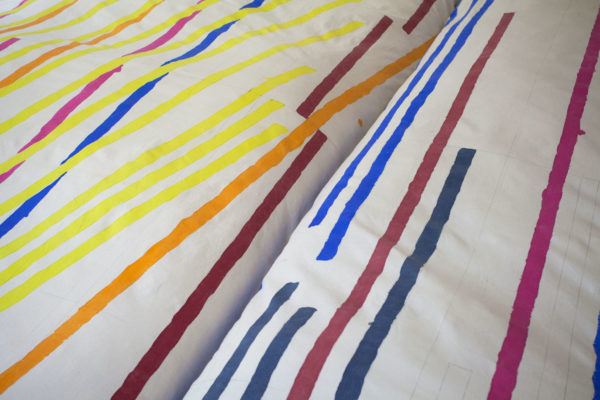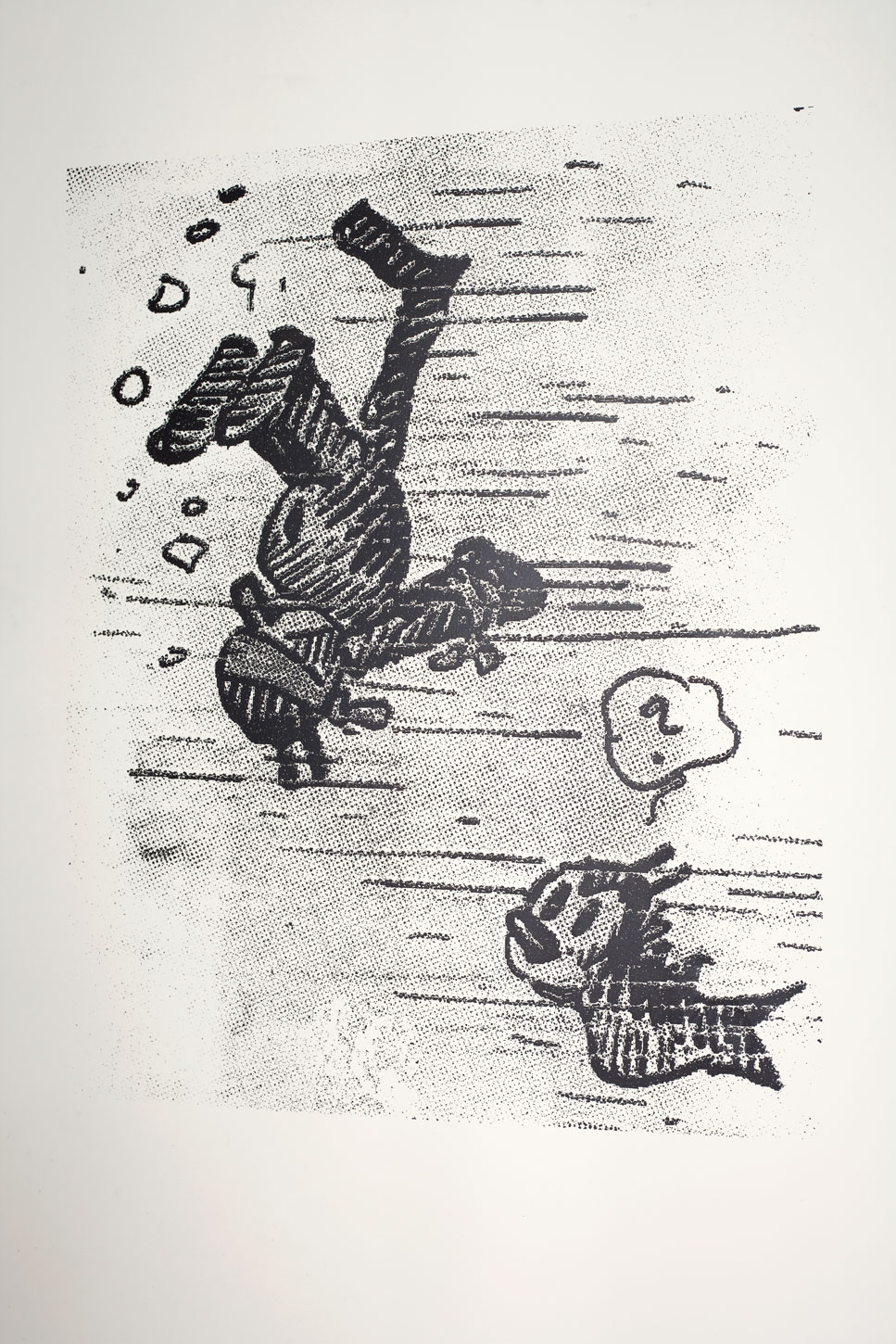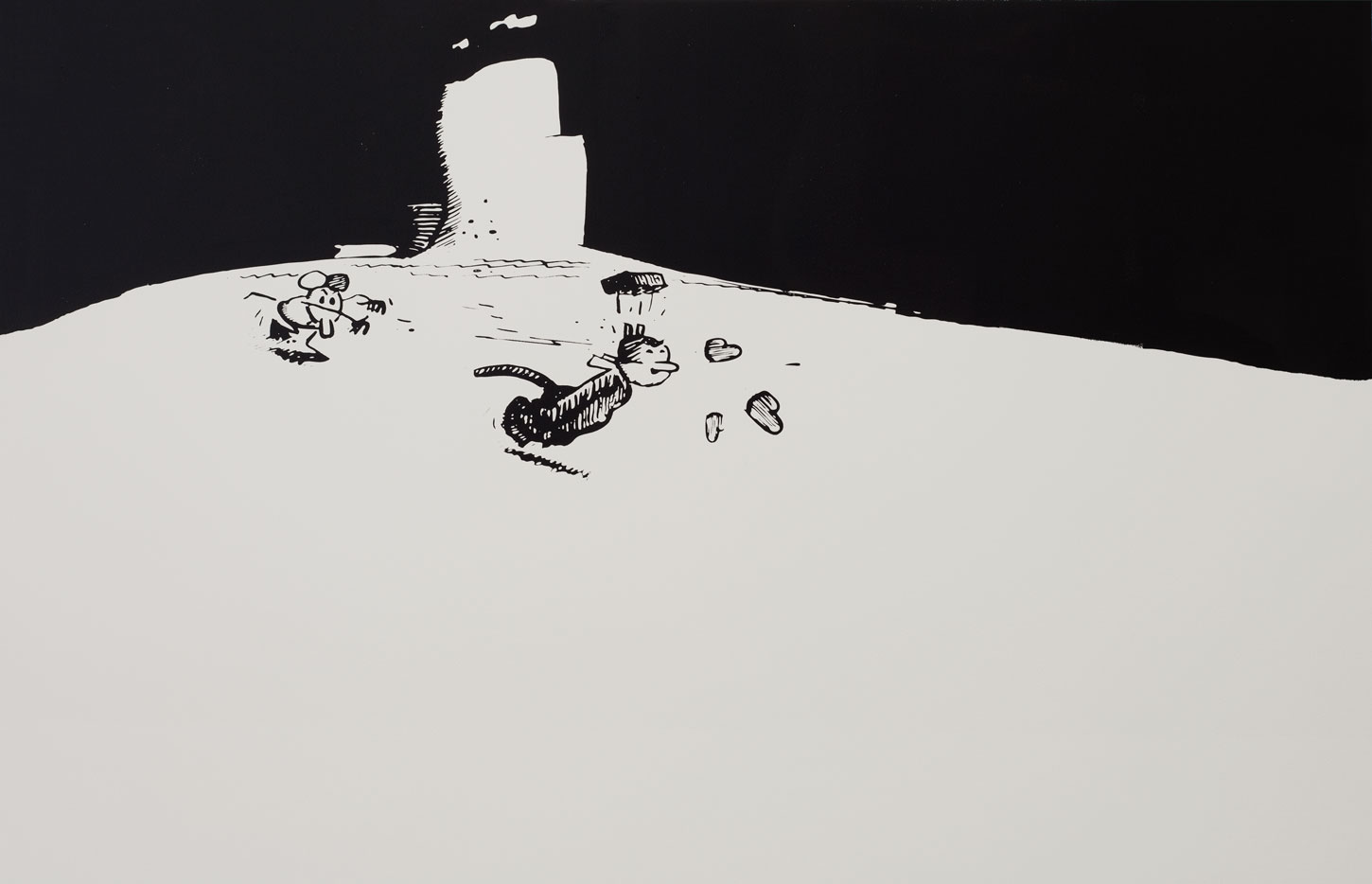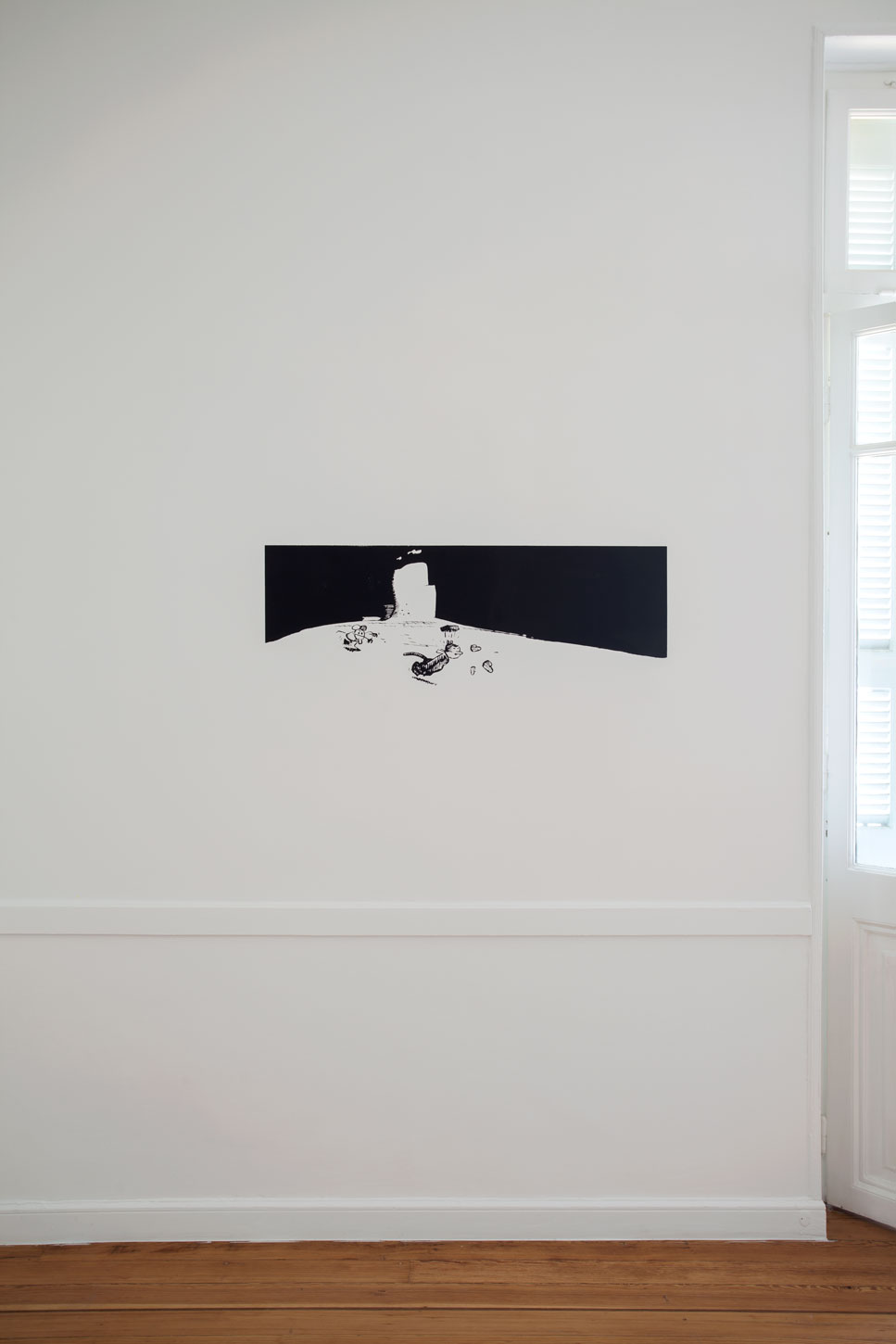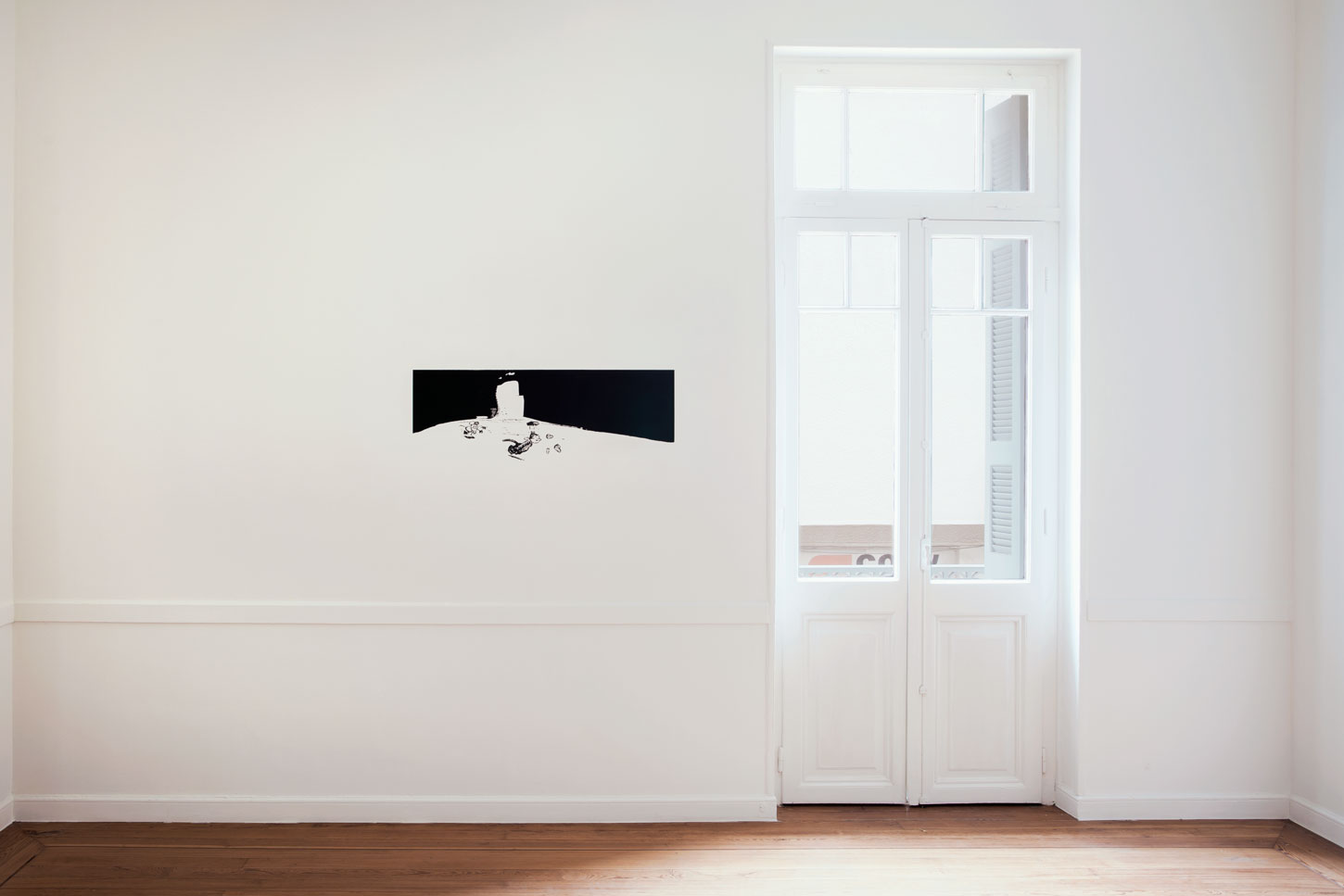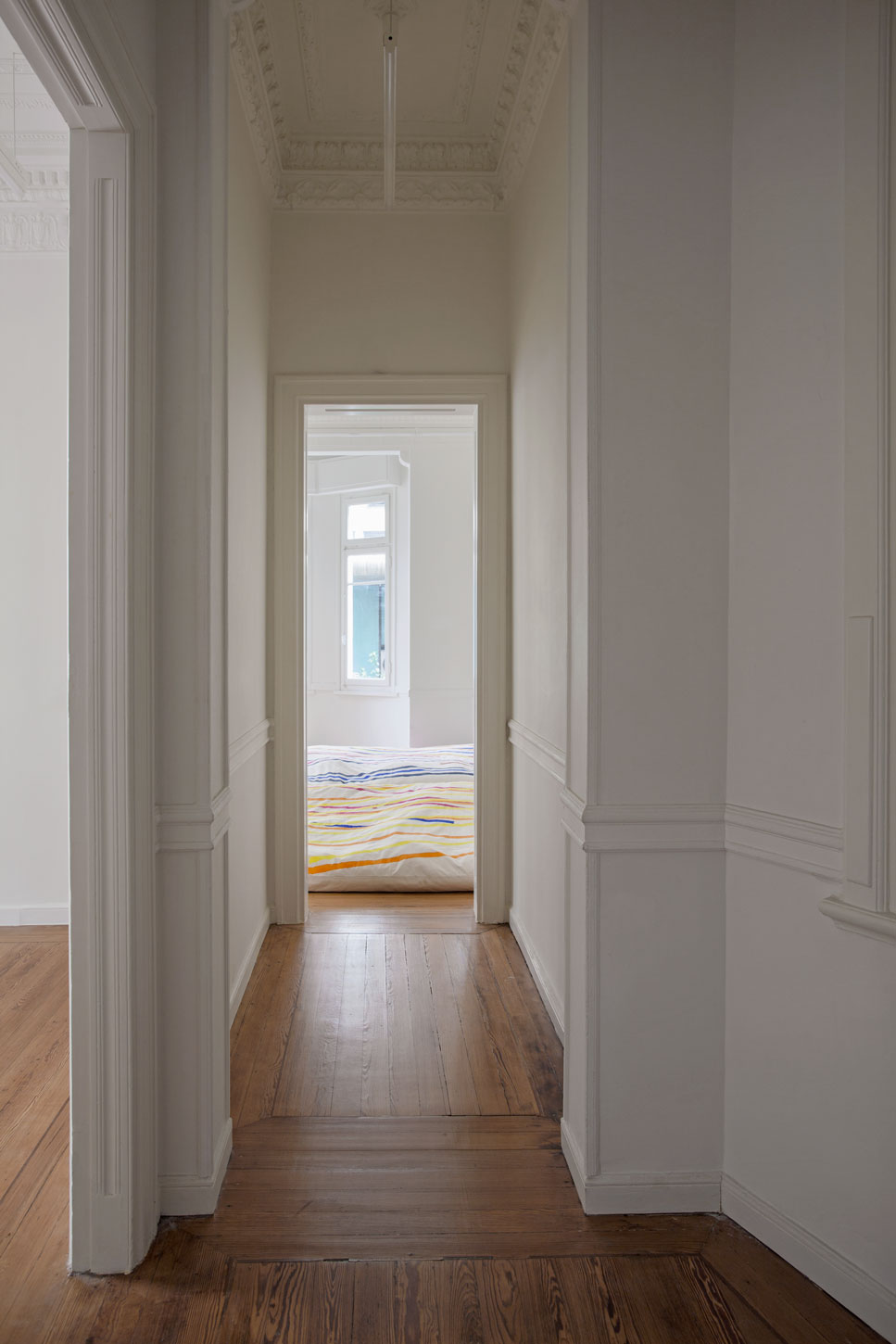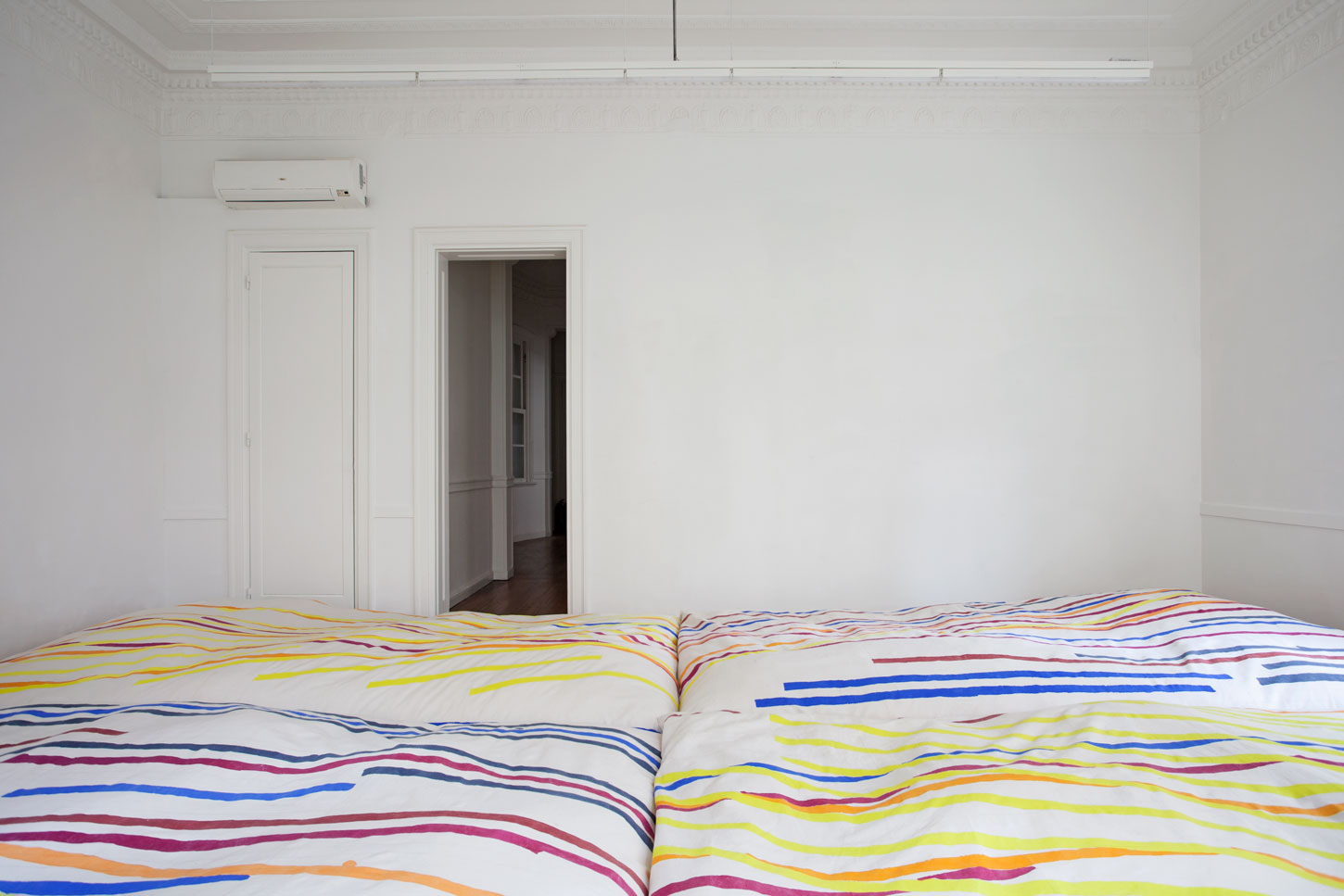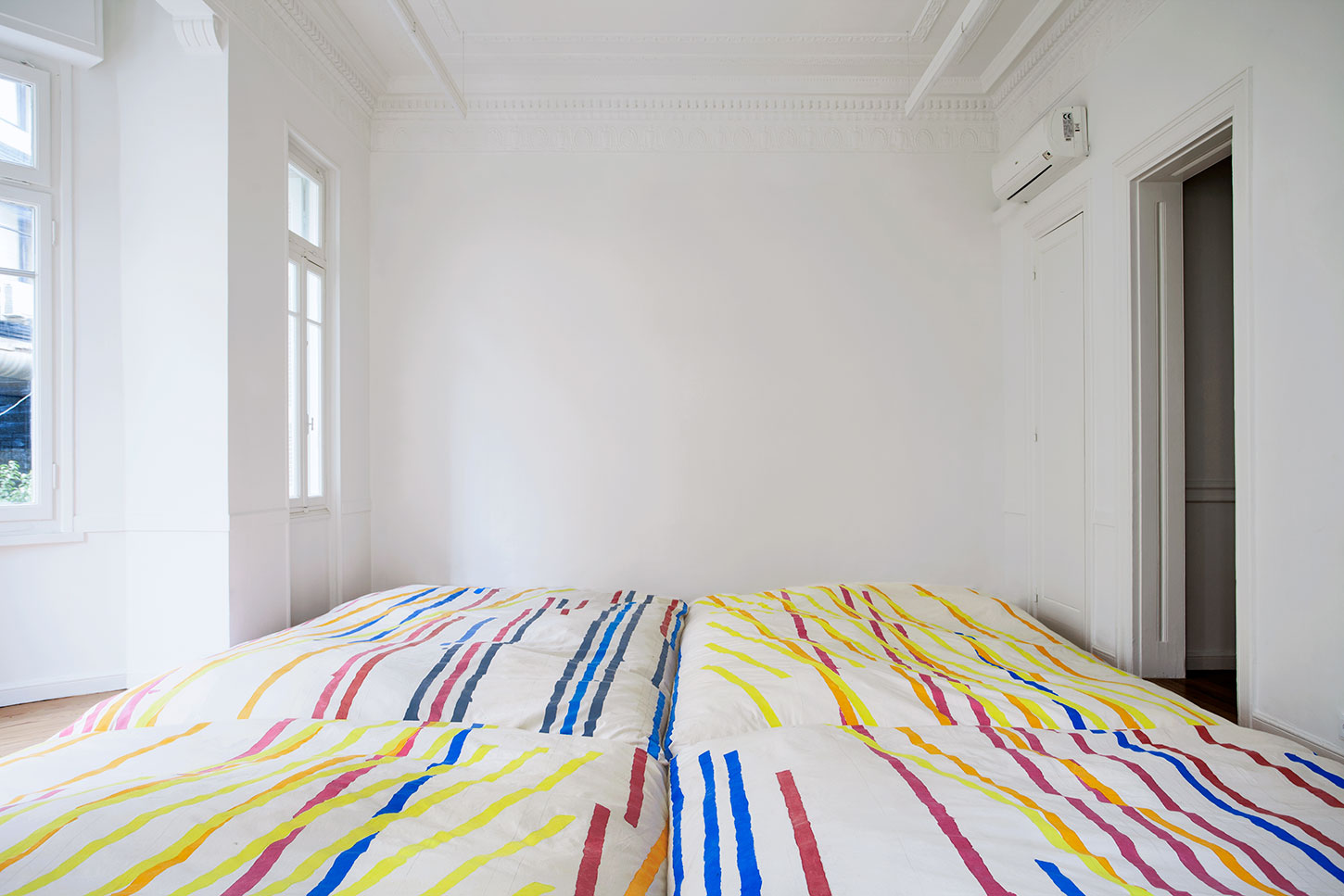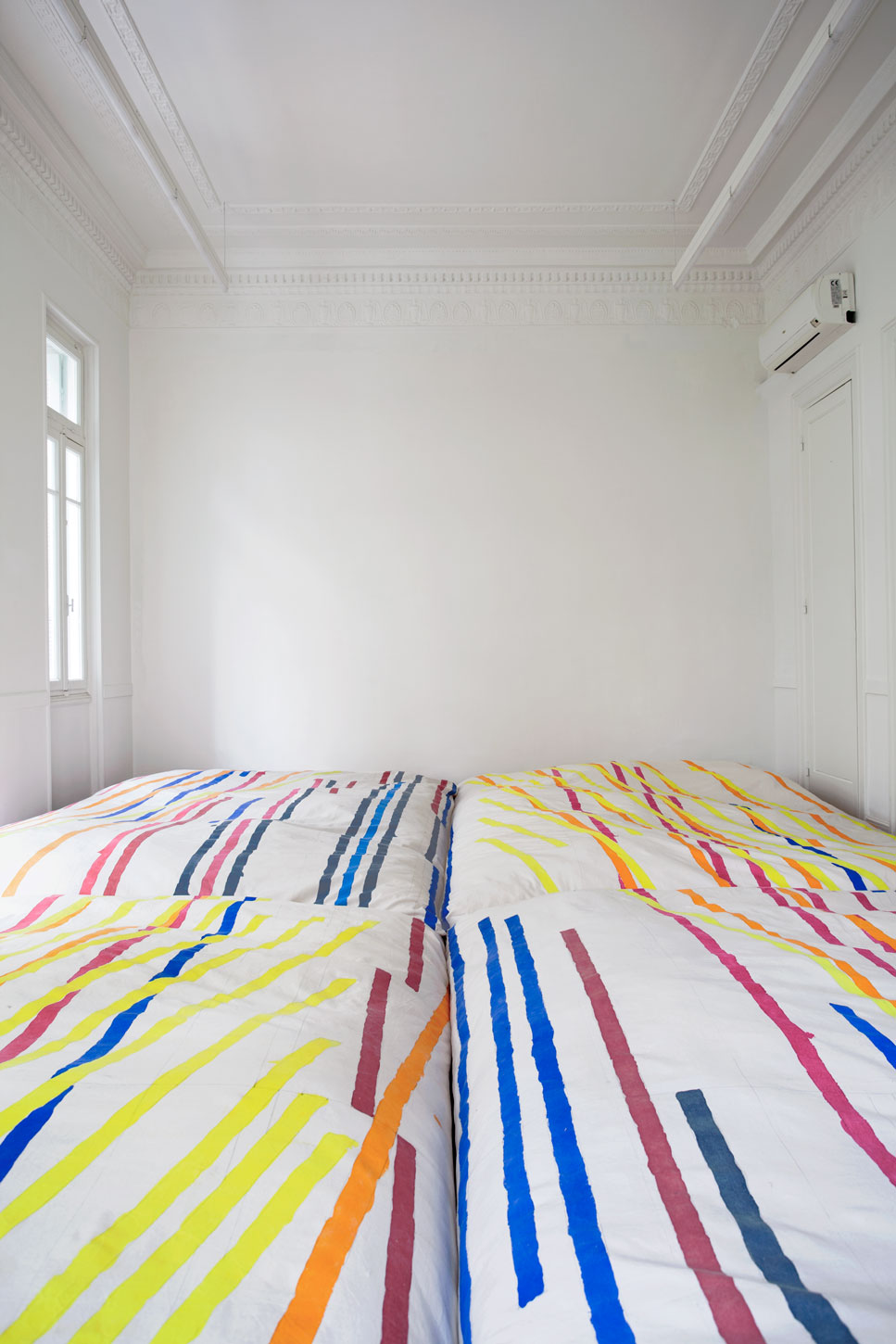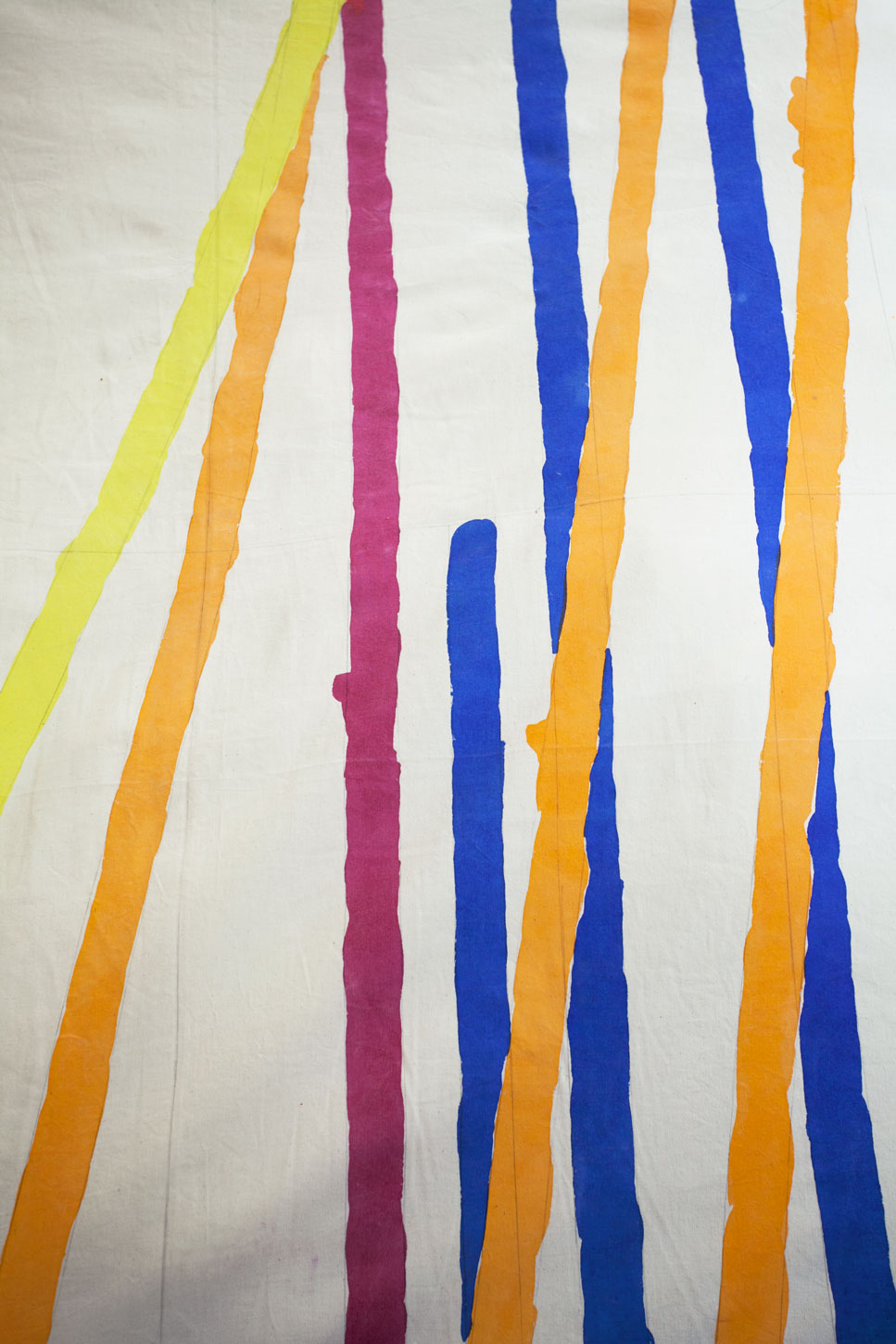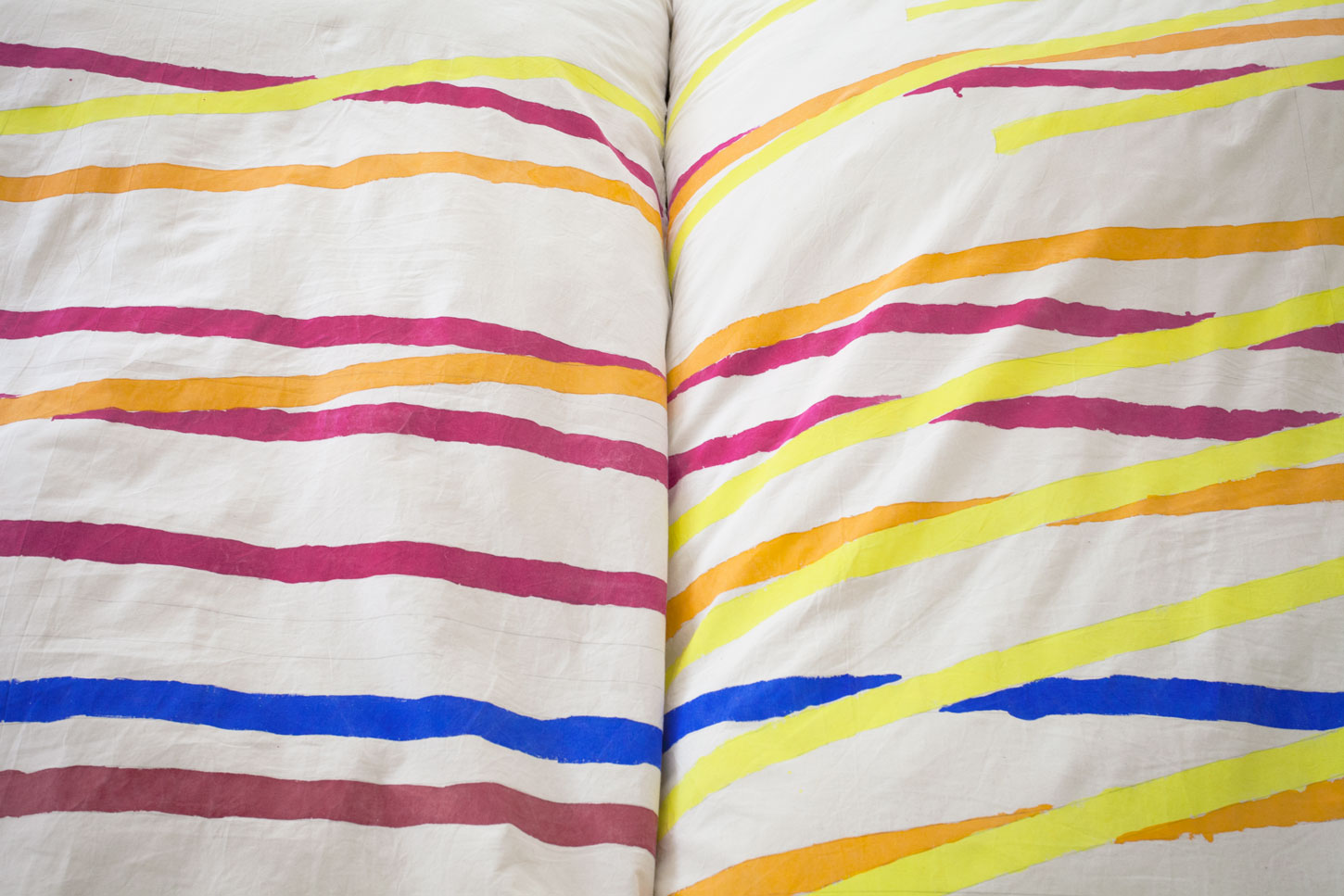If this show had stage directions, they would read something like this:
“The sun rises – Ignatz hurls a brick at Krazy – the sun sets.
This would repeat endlessly or, at least, until the sun died.”
***
“Sun Rises Sun Sets by Dora Economou and Katfish by Ellen Gallagher” is counterpart of an exhibition that opened in Rotterdam earlier in September 2021. It is co-curated with Shimmer’s Eloise Sweetman and Jason Hendrik Hansma, and forms part of their exhibition series “World as Lover, World as Self” inspired by the writings of environmental activist and Buddhist scholar Joanna Macy, and in particular Macy’s 1991 book of the same title.
In her monumental work, Macy argues that people look at the world roughly in four ways: the world as battlefield, trap, lover, or self. World-as-lover types consider the phenomenal world as an intimate and gratifying partner that offers them erotic affirmation. They feel themselves continually “embraced in the erotic play of life.” World-as-self types once fell in love with the world. Like lovers do, they sought for union, until finally they fell into oneness with it; the bonds of their limited ego snapped; their individual hearts merged with their world; a blazing unity that knows no bounds came into being!
Gallagher strips “Katfish”’s two panels from some three thousand strips of the celebrated serialized comic “Krazy Kat” by George Herriman, which ran from 1913 to 1944 in the “New York Evening Journal.” In keeping with Herriman’s method of having the backdrop in a continual state of agitation, Gallagher has shifted the panels from the printed page to the wall. In the attitude of a contortionist, scrubbed-down plaster becomes the blank space behind Herriman’s characters; it is there they must set. The plot follows Krazy Kat nursing an unrequited love for Ignatz Mouse, whose joy is to “krease that Kat’s bean with a brick.” Krazy takes the brick as a symbol of love, unable to appreciate Ignatz’s efforts. Ignatz unwittingly cements Krazy’s infatuation with every throw. This is the major premise; that the brick has little to do with the violent endings of other strips, for it is surcharged with emotions.
In the brickless panel, Krazy is maneuvered to fall off a vagrant crew’s boat led by Ignatz, and is left to bob around in the wash. Stupefied, Katfish – Krazy’s aquatic cousin – gawps at them sinking and their slipstreams merge. The compounded improbabilities of Herriman’s imaginary create a world that is never actually made clear, just like Krazy’s own gender, varying fluidly from strip to strip. As Herriman once said to film director Frank Capra when asked to define Krazy’s sex: “[Krazy is] something like a sprite, an elf. They have no sex. So that Kat can’t be a he or a she. The Kat’s a spirit – a pixie – free to butt into anything.”
The elasticity of Herriman’s world extends beyond cartoon physics to include psychic forces; faced with Ignatz’s repeated blows, Krazy displays resolute cheer. It is not the physical injuries he recovers from, but mostly the injuries sustained by a harsh world making itself known. Going back to Macy’s text, we could say that Krazy views the world as lover and as self. “I used to think that I ended with my skin,” Macy writes, “that everything within the skin was me and everything outside the skin was not […] what I am is a ‘flow-through.’ I am a flow-through of matter, energy, and information, which is transformed in turn by my own experiences and intentions […]; systems thinkers Kenneth and Elise Boulding suggest that we could simply call that ‘agape’ – the Greek word for love.”
Lain supine, afloor in the front room: four swells. Dora Economou’s “Sun Rises Sun Sets”, drawings of the sun rising and setting across the horizon are inundated in fabric covering a soft expanse on the floorboards. Colored lines of light appear unwavered from a distance, but quiver from up close. Sunrises are dialled to face East; Sunsets West. When the visitors are instructed not to step on them, Economou’s swells mark the distances between them, limiting their movement to a slim rectangular frame of exposed wooden floor. When the visitors are encouraged to gently lie down on them, or sleep on them, the swells ebb and flow. Each body hollows out a slight depression, causing the filling to spread milkily over to the side, which then regains volume. The alternate fall and rise caused by the bodies’ successive impressions obliterates older traces and inscribes the new. Beyond action, Economou’s quasi-corpus – to use Ferreira Gullar’s neo-concretist term, has a quiet glow. Though it concerns itself with two mundane optical phenomena, it affords its viewers a heightened perception, or a deepening of the ability to just feel. After all, as Economou has said, sunsets and sunrises are among the very few things that never cease to make sense.
“Sun Rises Sun Sets” is an ongoing series of photographs, slides, drawings, sculptures, and a book that Economou has worked on since the spring of 2020. In Rotterdam, it is introduced as a reel of slides of sunsets and sunrises, two origami sculptures, and an imprint of the work presented at Akwa Ibom.
***
Dora Economou (1974) was born in Athens, where she lives and works. She is a graduate of the Athens School of Fine Arts and Pratt Institute, New York. She works on sculptures, photography and staged sketches of props and men. She is concerned with materials, their inherent capacities, their metamorphosis when paired in distinct contexts, their relationships with found text and image. Her work has been exhibited internationally, including at Radio Athènes; Athens Municipality Art Centre; National Museum of Contemporary Art (EMST); Onassis Foundation Cultural Centre; DESTE Foundation; The Breeder; 2nd & 3rd Athens Biennale; Gazonrouge, Athens; Palinsesti, San Vito al Tagliamento; Transmission, Glasgow; Artspace, Sydney; 1st Saint-Tropez Cultural Summer. She is represented by RIBOT Arte Contemporanea, Milan; and Françoise Heitsch, Munich.
Born in Providence, Rhode Island, Ellen Gallagher (1965) lives and works between Rotterdam, the Netherlands, and New York, United States of America. Gallagher builds intricate, multi-layered works that pivot between the natural world, mythology, and history. Her process involves undoing and reforming trains of thought, often over long periods of time and across linked bodies of works. Over a highly multifaceted career, Gallagher’s work has been united by what she calls a “jitter,” an intellectual approach in which aesthetic possibilities are shaken loose from seismic cracks beneath the surface of cultural entities normally thought to be unshakable and impermeable. Encompassing painting, drawing, collage, and celluloid-based projections that fuse technique and material into syncretic form, her arresting compositions are a process of recovery and reconstitution through the accumulation and erasure of media – a process resulting in palimpsestic and topographic surfaces that are often carved, inlaid, mounted, printed, blotted and inscribed. Gallagher’s work is included in many major international museum collections, including MoMA, New York; Albright Knox Art Gallery, Buffalo; The Metropolitan Museum of Art, New York; The Art Institute of Chicago; MCA Chicago; MOCA, Los Angeles; Philadelphia Museum of Art, New York; Whitney Museum of Art, New York; Tate Modern, London; The Irish Museum of Modern Art, Dublin.
Shimmer is a curatorial studio established by Eloise Sweetman and Jason Hendrik Hansma in 2017. Shimmer is influenced by “Shimmer, when all you love is being trashed,” the talk by anthropologist and feminist theorist Deborah Bird Rose. Her learning pushes us to be humbled to pay attention and listen. In this way, we hope the artworks, artists, audiences, and materials gather and stretch across and over time. Alongside our expanded exhibitions are our events program “Sunday Mornings with”, as well as an informal online reading aloud program “Across The Way with…” and an online mixtape “On The Waves With…”. In this way Shimmer moves into both the personal and the public space.
***
This exhibition was made possible through the generous support of NEON Organization for Culture and Development, and The Carved to Flow Foundation. With thanks to Tind, Athens, and Eleanor Lines for providing the silkscreen frames.
ΕΛ.
ΕΓΚΑΙΝΙΑ Τετάρτη 15 Σεπτεμβρίου 2021, 16:00-21:00, ΔΙΑΡΚΕΙΑ 18 Σεπτεμβρίου – 15 Νοεμβρίου 2021
ΗΛΙΟΣ ΑΝΑΤΕΛΛΕΙ, ΗΛΙΟΣ ΔΥΕΙ ΤΗΣ ΝΤΟΡΑΣ ΟΙΚΟΝΟΜΟΥ ΚΑΙ KATFISH ΤΗΣ ELLEN GALLAGHER
Επιμέλεια: Akwa Ibom (Αθήνα) και Shimmer (Ρότερνταμ)
Αν η έκθεση αυτή είχε σκηνικές οδηγίες, αυτές θα έλεγαν κάτι τέτοιο:
«Ο ήλιος ανατέλλει – ο Ignatz πετάει ένα τούβλο στον/στην Krazy – ο ήλιος δύει.
Αυτό θα επαναλαμβανόταν στο διηνεκές ή, τουλάχιστον, ώσπου να πεθάνει ο ήλιος.»
***
Το «Ήλιος ανατέλλει, ήλιος δύει της Ντόρας Οικονόμου και Katfish της Ellen Gallagher» αποτελεί μέρος της ομότιτλης έκθεσης που άνοιξε για το κοινό νωρίτερα τον Σεπτέμβριο του 2021 στο Ρότερνταμ. Σε συνεπιμέλεια με την Eloise Sweetman και τον Jason Hendrik Hansma του Shimmer, αποτελεί μέρος της σειράς εκθέσεών τους «World as Lover, World as Self», η οποία δανείζεται τον τίτλο της από τα κείμενα της περιβαλλοντικής ακτιβίστριας και σπουδάστριας του βουδισμού Joanna Macy, και συγκεκριμένα από το βιβλίο της που εκδόθηκε για πρώτη φορά το 1991.
Σε αυτό το κείμενό της η Macy υποστηρίζει ότι οι άνθρωποι βλέπουν τον κόσμο με τέσσερις διαφορετικούς τρόπους: ως πεδίο μάχης, παγίδα, εραστή ή εαυτό. Εκείνοι που τον προσεγγίζουν ως εραστή, τον βιώνουν παράλληλα ως έναν οικείο και δοτικό σύντροφο που τους παρέχει ερωτική επιβεβαίωση – και κατ’ επέκταση οντολογική επικύρωση· νιώθουν συνεχώς «αγκαλιασμένοι στο ερωτικό παιχνίδι της ζωής». Εκείνοι που προσεγγίζουν τον κόσμο ως εαυτό είναι αυτοί που κάποτε τον ερωτεύτηκαν αλλά θέλησαν ταυτόχρονα να ενωθούν μαζί του· οι δεσμοί του πεπερασμένου τους εγώ έσπασαν και οι καρδιές τους συγχωνεύτηκαν με τον κόσμο.
Στο έργο της «Katfish» η Gallagher απομονώνει δύο πάνελ από τα περίπου τρεις χιλιάδες στριπάκια της σειράς κόμικ «Krazy Kat» του George Herriman, το οποίο κυκλοφόρησε από το 1913 έως το 1944 στο «New York Evening Journal». Απηχώντας την πρακτική του Herriman, ο οποίος προσδίδει στο φόντο των πάνελ του καταστάσεις συνεχούς αναταραχής, η Gallagher μεταφέρει τα πάνελ του από την τυπωμένη σελίδα στον τοίχο. Η επιφάνεια του τριμμένου σοβά, σε συνδυασμό με την υφή της μεταξοτυπίας παρεισφρέει ενεργά στον κόσμο του Herriman, οδηγώντας τον να αναπτύξει μια υβριδική, ασυνήθη αρχιτεκτονική παρουσία μέσα από το οικοδομικό υλικό – άλλωστε η λέξη «σοβάς» είναι δάνειο από το τουρκικό ρήμα «sıvamak», που σημαίνει «εμποτίζω»». Σύμφωνα με την πλοκή του κόμικ, ο/η Krazy Kat είναι ερωτευμένος/η με τον Ignatz Mouse, ο οποίος προσπαθεί πεισματικά να τον/την απορρίψει, αλλά και να τον/την αποθαρρύνει πετώντας του/της συνέχεια τούβλα. Ο/Η Krazy ερμηνεύει το τούβλο του Ignatz Mouse ως σύμβολο αγάπης, ανίκανος/ανίκανη να εκτιμήσει το πραγματικό κίνητρο πίσω από τις «προσπάθειες» του Ignatz. Έτσι, με κάθε του ρίψη, ο Ignatz κάνει άθελά του όλο και πιο δυνατό τον έρωτα του/της Krazy για αυτόν. Αυτή είναι και η βάση της πλοκής: το τούβλο, επιφορτισμένο καθώς είναι με συναισθήματα, δεν θα φέρει κάποια βίαιη κατάληξη, όπως συμβαίνει με άλλα στριπ.
Στο πάνελ που δεν περιέχει τούβλο, ο Ignatz και το πλήρωμά του έχουν ρίξει τον/την Krazy από ένα πλοίο στoν αφρό της θάλασσας. Ο Katfish, ο υδρόβιος ξάδερφος του/της Krazy, τον/την κοιτάει και αναρωτιέται τι συνέβη. Οι σύνθετες απιθανότητες της φαντασίας του Herriman δημιουργούν έναν κόσμο που δεν οριοθετείται, όπως ακριβώς και το φύλο του/της Krazy, που παραμένει ρευστό από στριπ σε στριπ. Όπως είπε κάποτε ο Herriman στον σκηνοθέτη Frank Capra όταν αυτός τον ρώτησε για το φύλο του/της Krazy: «[Ο/Η Krazy είναι] κάτι σαν νεράιδα, σαν ξωτικό. Δεν μπορεί να είναι “αυτός” ή “αυτή”. Ο/Η Kat είναι πνεύμα – αερικό – ελεύθερο να παρεισφρήσει παντού».
Αυτή η ελαστικότητα στον Herriman εκτείνεται πέρα από τους νόμους της φυσικής που συναντάμε στα καρτούν («cartoon physics»), ώστε να συμπεριλάβει τις ψυχικές ενορμήσεις των χαρακτήρων του. Αντιμέτωπος/αντιμέτωπη με τα αλλεπάλληλα χτυπήματα του Ignatz, ο/η Krazy εμφανίζει μια απτόητη ευδαιμονία. Δεν εστιάζει τόσο στους σωματικούς τραυματισμούς, από τους οποίους αναρρώνει σχεδόν θαυματουργικά, όσο στα ψυχικά τραύματα που βιώνει όταν έρχεται αντιμέτωπος/αντιμέτωπη με τον κόσμο που ξεπροβάλλει ανόθευτος. Επιστρέφοντας στο κείμενο της Macy, θα μπορούσαμε να πούμε ότι ο/η Krazy βλέπει τον κόσμο ως εραστή και ως εαυτό. «Παλιά νόμιζα ότι τελείωνα εκεί όπου φτάνει το δέρμα μου», γράφει η Macy, «ότι ήμουν όλα όσα περίκλειε και οτιδήποτε έξω από αυτό δεν αποτελούσε μέρος μου […], αυτό που είμαι, όμως, είναι τελικά μια “ροή”, η οποία διαμορφώνεται με τη σειρά της από τις εμπειρίες και τις προθέσεις μου οι οποίες αποτελούν κι αυτές άλλη μια μετεμψύχωση της ύλης, της ενέργειας και της πληροφορίας· οι θεωρητικοί συστημάτων Kenneth και Elise Boulding προτείνουν ότι θα μπορούσαμε με μια λέξη να ονομάσουμε αυτή τη ροή “αγάπη”».
Ακουμπισμένα σε ύπτια θέση, στο πάτωμα στο μπροστινό δωμάτιο: τέσσερα φουσκώματα. Το «Ήλιος ανατέλλει, ήλιος δύει» της Ντόρας Οικονόμου αποτυπώνει την ανατολή και τη δύση πάνω σε μια απαλή έκταση από βαμβακερό ύφασμα που καλύπτει τη μεγαλύτερη επιφάνεια του δαπέδου. Πολύχρωμες γραμμές φωτός από μακριά φαίνονται ασάλευτες, ενώ από κοντά τρέμουν. Οι ανατολές καλούνται να κοιτάξουν προς την ανατολή· τα ηλιοβασιλέματα προς τη δύση. Όταν μας ζητείται να μην πατήσουμε πάνω στα γλυπτά, τα φουσκώματα της Οικονόμου μετρούν τις αποστάσεις ανάμεσά μας, περιορίζοντας την κίνησή μας σε ένα λεπτό ορθογώνιο πλαίσιο από εκτεθειμένο ξύλινο δάπεδο. Όταν μας ενθαρρύνουν να ξαπλώσουμε μαλακά πάνω τους, ακόμα και να κοιμηθούμε, αυτά πλέουν. Κάθε σώμα αποτυπώνει ένα κοίλωμα, προκαλώντας τη γαλακτώδη γέμιση να εξαπλωθεί στο πλάι, προσδίδοντας εκεί όγκο. Η εναλλακτική πτώση και άνοδος που προκαλούν οι διαδοχικές αποτυπώσεις των σωμάτων, σβήνει τα προηγούμενα ίχνη και εγγράφει νέα. Πέρα από τη δράση, το quasi-corpus της Οικονόμου – σύμφωνα με την ορολογία της νεο-συγκεκριμένης τέχνης (neo-concretist) της Ferreira Gullar– εκπέμπει μια ήπια φωτεινότητα που εμπεριέχει μια απροσδιόριστη ησυχία. Αν και καταπιάνεται με δύο καθημερινά οπτικά φαινόμενα, μέσα από την φαινομενολογική της διάσταση η εγκατάσταση οξύνει την αντίληψή τους, κάνοντας παράλληλα πιο βαθιά την ικανότητά μας να τα συναισθανθούμε, εκτός των άλλων, ως δύο από τα ελάχιστα πράγματα που δεν παύουν ποτέ να έχουν νόημα, όπως έχει πει και η Οικονόμου.
Το «Ήλιος ανατέλλει, ήλιος δύει» είναι ένα έργο σε διαρκή εξέλιξη, το οποίο αποτελείται από μια σειρά φωτογραφιών, σλάιντ, σχεδίων, γλυπτών και ενός βιβλίου που δουλεύει η Οικονόμου από την άνοιξη του 2020. Στο Ρότερνταμ αποτελείται από μια σειρά σλάιντ με εικόνες της ανατολής και της δύσης, δύο γλυπτά οριγκάμι και ένα αποτύπωμα του έργου που παρουσιάζεται στην Akwa Ibom.
***
Η Ντόρα Οικονόμου (1974) γεννήθηκε στην Αθήνα, όπου ζει και εργάζεται. Είναι απόφοιτος της Ανωτάτης Σχολής Καλών Τεχνών της Αθήνας και του Pratt Institute της Νέας Υόρκης. Το περιεχόμενο της πρακτικής της είναι γλυπτικό, χειροποίητο, βασισμένο στη διαδικασία και προσανατολισμένο στο υλικό, ωστόσο η ίδια προσπαθεί να προσεγγίσει την καλλιτεχνική δημιουργία από την οπτική γωνία της ιστοριοποιού.
Γεννημένη στο Πρόβιντενς (Ρόουντ Άιλαντ), η Ellen Gallagher (1965) ζει και εργάζεται μεταξύ του Ρότερνταμ και της Νέας Υόρκης. Τα έργα της, πολυσύνθετα και λεπτομερή, περιστρέφονται μεταξύ του φυσικού κόσμου, της μυθολογίας και της ιστορίας. Η πρακτική της χαρακτηρίζεται από τη διαρκή αναίρεση και ανασυγκρότηση των συρμών της σκέψης της, κατά τη διάρκεια μεγάλων χρονικών διαστημάτων και διατρέχοντας ένα σώμα διασυνδεδεμένων έργων. Περιλαμβάνει ζωγραφική, σχέδιο, κολάζ και προβολές.
***
Mε την υποστήριξη του Οργανισμού Πολιτισμού και Ανάπτυξης ΝΕΟΝ και του Carved to Flow Foundation. Ευχαριστούμε επίσης τους Τind, όπως και την Eleanor Lines για την παροχή των τελάρων μεταξοτυπίας.
